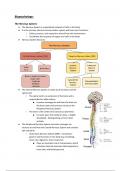Biopsychology:
The Nervous System:
● The Nervous System is a specialised network of cells in the body
● It is the primary internal communication system with two main functions:
○ Collect, process, and respond to stimuli from the environment
○ Coordinate the response of organs and cells in the body
● Nervous System divisions:
● The Central Nervous System is made up of the brain and the
spinal cord
○ The spinal cord is an extension of the brain and is
responsible for reflex actions
■ It passes messages to and from the brain via
the brain stem and connects nerves to the
Peripheral Nervous System
○ The brain is the centre of all conscious awareness
■ Its outer layer, the cerebral cortex, is highly
developed - distinguishing us from other
animals
● The Peripheral Nervous System transmits messages via
neurons to and from the Central Nervous System and contains
two sub-parts:
○ Autonomic Nervous System (ANS) - involuntary -
governs vital functions in the body (e.g. breathing,
heart rate, digestion, stress response)
■ Plays an important role in homeostasis, which
maintains internal processes like temperature,
heart rate, and blood pressure
, ■ Comprised of the Sympathetic Nervous System and the Parasympathetic
Nervous System
● The Sympathetic Nervous System - Fight or Flight
○ Impulses travel to organs in the body to help us prepare for
action when we are faced with a dangerous situation
○ Heart rate, blood pressure, and breathing rate increase, and
less important functions like digestion, salivation, and desire
to urinate are suppressed
● The Parasympathetic Nervous System - Rest or Digest
○ Relaxes the body and returns to ‘normal’ resting state →
slows down heart rate and breathing rate, and reduces
blood pressure
○ Any functions that were previously slowed down during fight
or flight reactions are started up again
○ Somatic Nervous System (SNS) - voluntary - controls muscle movements and
connects the brain to motor neurons
Organ Effect of Sympathetic Stimulation Effect of Parasympathetic
Stimulation
Heart Increased rate, increased force of Decreased rate, decreased force of
contraction (of whole heart) contraction (of atria)
Lungs Dilation of bronchioles, inhibition Contraction of bronchioles,
of mucus secretion stimulation of mucus secretion
Digestive Tract Decreased motility, inhibition of Increased motility, stimulation of
digestive secretions mucus secretion
Urinary Bladder Relaxation Contraction (emptying)
Eye Dilation of the pupil, adjustment Contraction of the pupil,
of the eye for far vision adjustment of the eye for near
vision
Liver (glycogen store) Glycogenolysis (glucose released) None
Adipose Cells (fat store) Lipolysis (fatty acids released) None
● In the human context, the signals carried by the
large-diameter, myelinated neurons that link the
spinal cord to the muscles can travel at speeds
ranging from 70-120m/s → which equates to
156-270 miles per hour
● In comparison, the same signals travelling along the
same paths being carried by small-diameter,
unmyelinated fibres of the pain receptors travel at
speeds ranging from 0.5-2.0m/s
, ● Chemical messages are sent between neurons via synapses
○ Axon: the end part of a neuron which sends out neurotransmitters
○ Dendrite: the beginning of the next neuron which receives the neurotransmitter
● The major neurotransmitters that work in the brain:
○ Adrenaline, Noradrenaline, Dopamine, Serotonin, GABA, Acetylcholine, Glutamate,
Endorphins
○ The chemical message they send across the synapse is then turned into an electrical
impulse within the receiving end of the neuron they reach (the dendrite)
● Neurotransmitters are either excitatory or inhibitory → they either increase activity in the
neuron they reach or decrease it
○ They increase or decrease the likelihood of electrical impulses moving forwards
along the neuron
● Sensory neurons carry
messages from the PNS to
the CNS → they have long
dendrites and short axons
● Relay neurons connect the
sensory neurons to the
motor or other relay neurons
→ they have short dendrites
and short axons
● Motor neurons connect the
CNS to effectors, such as
muscles and glands → they
have short dendrites and
long axons
● Communication between and within neurons is
chemical
● Neurons fire when their electrical charge reaches
the threshold of excitation → when it is reached,
they send an electrical charge or impulse down
the axons, called an ‘action potential’
● When a neuron is resting, it is negatively charged,
compared to the outside of the cell
● When it is activated by a stimulus, it becomes
positively charged - action potential




